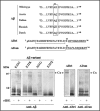The irreversible binding of amyloid peptide substrates to insulin-degrading enzyme: a biological perspective
- PMID: 19098445
- PMCID: PMC2634517
- DOI: 10.4161/pri.2.2.6710
The irreversible binding of amyloid peptide substrates to insulin-degrading enzyme: a biological perspective
Abstract
Insulin-degrading enzyme (IDE) is a conserved Zn(2+)metalloendopeptidase involved in insulin degradation and in the maintenance of brain steady-state levels of amyloid beta peptide (Abeta) of Alzheimer's disease (AD). Our recent demonstration that IDE and Abeta are capable of forming a stoichiometric and extremely stable complex raises several intriguing possibilities regarding the role of this unique protein-peptide interaction in physiological and pathological conditions. These include a protective cellular function of IDE as a "dead-end chaperone" alternative to its proteolytic activity and the potential impact of the irreversible binding of Abeta to IDE upon its role as a varicella zoster virus receptor. In a pathological context, the implications for insulin signaling and its relationship to AD pathogenesis are discussed. Moreover, our findings warrant further research regarding a possible general and novel interaction between amyloidogenic peptides and other Zn(2+)metallopeptidases with an IDE-like fold and a substrate conformation-dependent recognition mechanism.
Figures




References
-
- Kurochkin IV. Insulin-degrading enzyme: embarking on amyloid destruction. Trends Biochem Sci. 2001;26:421–425. - PubMed
-
- Morelli L, Llovera RE, Alonso LG, Frangione B, de Prat Gay G, Ghiso J, Castaño EM. Biochem Biophys Res Commun. 2005;332:808–816. - PubMed
-
- Farris W, Mansourian S, Chang Y, Lindsley L, Eckman EA, Frosch MP, Eckman CB, Tanzi RE, Selkoe DJ, Guenette S. Insulin-degrading enzyme regulates the levels of insulin, amyloid β-protein, and the β-amyloid precursor protein intracellular domain in vivo. Proc Natl Acad Sci USA. 2003;100:4162–4167. - PMC - PubMed
-
- Salkovic-Petrisic M, Hoyer S. Central insulin resistance as a trigger for sporadic Alzheimer-like pathology: an experimental approach. J Neural Transm Suppl. 2007;72:217–233. - PubMed
Publication types
MeSH terms
Substances
LinkOut - more resources
Full Text Sources
Medical
